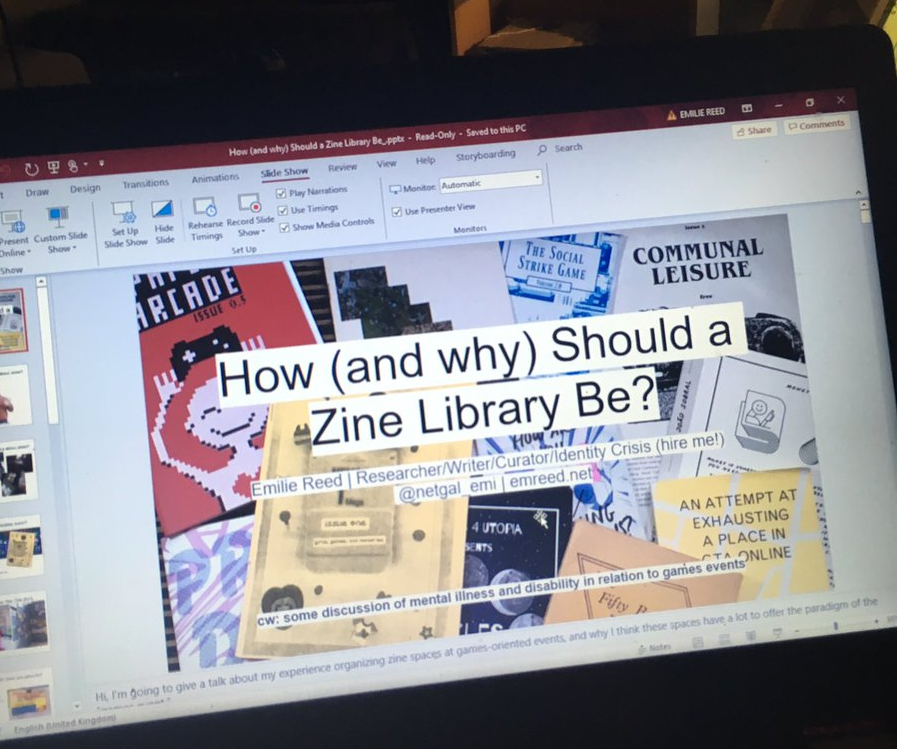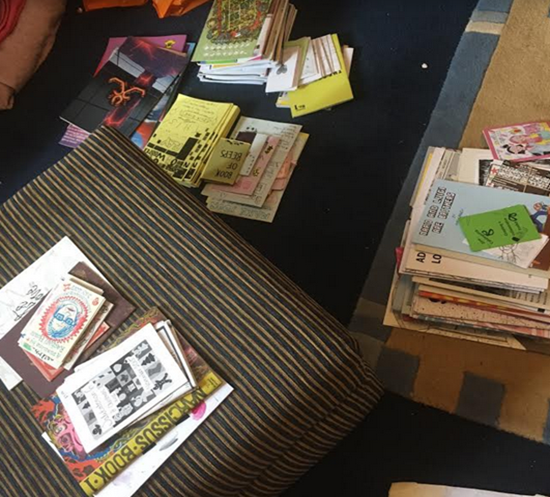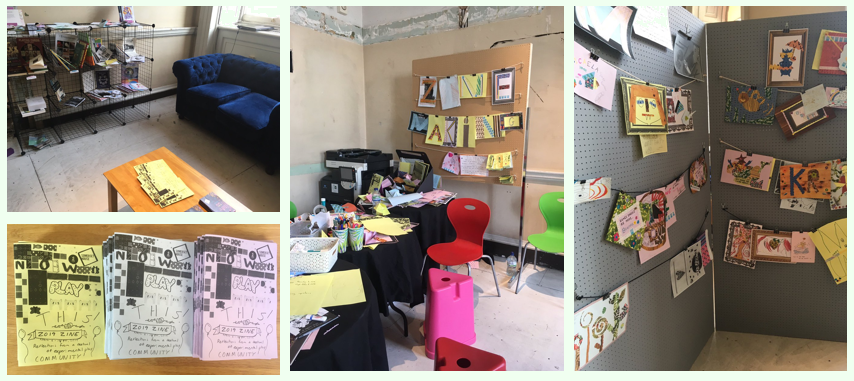
Posted by: Em | MAY-29-2019
This is the text of a talk I delivered at Feral Vector 2019, which took place in Hebden Bridge from May 23rd - 25th.

On paper, I’m a research student at the University of Abertay School of Design and Informatics which sounds very technical! But, I’m working within the department of art, games and media, writing a dissertation on exhibition strategies for presenting videogames in arts contexts. By training, I’m an art historian, but what I actually do in my research involves a lot more running around and fiddling with things than you’d expect.
So how did I get into zines? By wanting to make something, basically. The first zine I made about 3 years ago was done in the old-fashioned cut and paste way, and I mailed it to a friend I was deeply into Metal Gear Solid fanfiction with as a Christmas present. I found the process intuitive and fun, and you come away with a little publication you can share with people. I also got into some zine making jams in Dundee. Shortly after that I started working on videogame events with We Throw Switches and their Games Are For Everyone parties in Edinburgh.
When one of them featured Nathalie Lawhead’s Everything is Going To Be Ok, which she sometimes describes as a digital zine, I thought it would be cool to include a selection of zines about videogames, so that there was an alternate activity in addition to just playing games. By now, I’ve done this sort of thing several times, there is often a big stack of zines on the floor in my living room, and I end up ordering interesting zines online at least once a week… fortunately it’s not an expensive habit.

There’s already the thematic links that make zines an interesting addition to games events-- videogames are drawing their aesthetic and structural approaches from zines, and many zines are being made about videogames. The presence of zines also highlights the history of alternative modes of making and distribution that built “indie” communities before the internet, which a lot of people find inspiring. For people who are coming to their first games event, or people who are coming to games from a different area, a zine can be a more accessible way in to the event than just starting to play games, usually on a big screen or in front of a lot of people! It’s important to remember that more people know how to read than to skillfully use an Xbox controller, probably, and looking at a zine reveals more about how it was made than a videogame.
So, that was how I got my foot in the door to doing zine libraries. I was able to do the most elaborate realization of this at Now Play This, which was a 9-day long festival combining a variety of types of games, at Somerset House in London. I was given a fairly sizeable budget for acquiring zines and art supplies, and getting things like couches, copiers and so on was a part of their event hire. I was also paid to be there! This allowed me to do things like test out having both making and reading going on in a zine area, having a variety of ages and interests using a space, collecting material during the event and making a zine that combined my own record of the event with drawings people made in the space. The main elements of the space are comfy seating, shelves, separate art tables for making things, a copier, and a place for people to hang their work.

The things that worked about this space were, in my opinion, the fact that making something is fun, and unexpected in an exhibition space. When you have scissors and glue sticks and paper out people seem to right away know what to do, especially kids, in a way that is more transparent than sitting down at a computer. It also gives them something to take away from the exhibition, which can bring back the experience later. I also found that, when you’re working on “real material” there is much less of the “low average time to dick” problem that digital projects have. Perhaps because it’s more visible and if you’re adding inappropriate content you’re doing it in real space? This is just a hunch for now.
It also uses a different type of energy than playing a videogame or looking at a screen, which I think was important, especially for people who were learning the visual language and tactile requirements of videogames on the fly at the event. The zine space allowed people to communicate their feelings about the event and document them, which is very handy for an event that needs public funding! And for some people doodling or cutting and pasting and things like that ARE easier, which is cool, and for other people it can be a different type of challenge to their views of videogames, which is also cool.
The zine space also affected the event more broadly. It allowed for embedded documentation of the event. Videogame events and exhibitions are notoriously poorly documented which makes it hard to remember our history! Making an old-fashioned cut-and-paste style zine and then photocopying and assembling and distributing it in the space was an exciting way to incorporate this process into the event itself. The copier also allowed us to make ad hoc signage, such as a list of games in the boardgames area, when we realized we didn’t have anything indicating that. It also allowed us to make copies of forms that ran out in other areas of the exhibition quickly, and even make new feedback forms or templates to adapt to how people were responding to the exhibition. Overall it was very useful as a resource hub, because it was a place in the space where you could ALWAYS find some extra paper, pencils, etc.
Most interestingly, though, it became a space where people did a bunch of things that were NOT making zines. In fact the first girl to come sit at the table immediately said “I want to make a card for mummy” which was very hard to shoot down. Initially, I was frustrated by the portion of people not using the space for making/reading zines as I had intended. But then I realized, beyond a more low key, less technical spot to read or draw, it was offering some space for behaviors people often need to do but can’t in exhibition spaces or festivals or events.
So this talk is secretly about how we can make events or festivals and exhibition spaces better more generally. It doesn’t necessarily have to be a zine space… the elements of the zine space both provided people opportunities to read and create zines, and also addressed these needs that other exhibitions and festival’s use of space and layout did not. Any space can be a bit more responsive to this.
All people have mental, physical and emotional needs. Oftentimes taking care of these needs, especially if they diverge from a cultural norm, is made into a personal, rather than social or collective responsibility. This is the idea behind “self-care,” which is the impetus to take care of yourself on top of everything you’re already doing.
The problem is often not that we need to “do” mindfulness or breathing exercises or use bath bombs or new skin creams or order deliveroo or watch the new netflix series or whatever is being framed as “self care” in that moment, but that we’re already doing too much and need to not do anything!
Question-- Are you aware of mental health? This month or last week or something was some sort of “mental health awareness” period which means if you work for a large company or attend a university you probably received an email about how You Must Attend This Meditation Taster Session or you could pet dogs for 30 minutes or something.

Mark Fisher called this the “privatization of stress” and pointed out how pathologizing individual instances of anxiety or depression makes it a personal inadequacy rather than a common form of illness that is largely unaddressed and actually exacerbated by capitalist values and priorities.[1] On the other hand, what would be a collective solution? Socialized healthcare more comprehensively covering a greater variety of therapy is one example of a major change at the government level that would take collective responsibility for mental health. There’s also small-scale improvised solutions such as memeing on it which I think is a form of solidarity and consciousness raising.
Even more radically, Hamja Ahsan theorizes introverted, shy, mentally ill and neurodivergent people as a spectrum that are all marginalized by a normatively extrovert society. He explores why extroversion is presented as desirable within capitalism, and who benefits from this.[2] The semantic transition, from melancholia as something which could be a necessary retreat from the world or justified pondering of an external cause for despair, to depression as an illness and personal problem, takes place alongside the acceleration of capitalism. You can connect this to ideas of “emotional labor” where many of the most common and precarious low wage jobs demand an army of workers who can at least pretend to be cheery, sociable and polite all day.
So this can be treated as a structural problem, and we can investigate how our events and public-facing spaces are structured. These spaces, as they exist, often assume certain levels of mental health, energy, and sociability. Events, especially within the game dev space, are a LOT to do. They fill time to the brim with activities many people find intimidating and exhausting, and there are minimal opportunities for more quiet, small group, or lower energy activities, and sometimes even few options for getting away. The zine space, while still heavy on reading and making zines, was also a general space where needs people have that the typical event structure does not address could begin to be met.
Here’s a list. It can be a list of problems with your event, or a list of people who love your event if you make space for them, it’s up to you.
To conclude, and bring it back around to the topic of zine libraries, if you’ve taken in the concerns and ideas I raised in this talk and want to try doing a zine space at your event… ideally, if it is to work, it is a commitment. I hate to be a scold but--
A zine library is not just for your event, it's for life!
I feel like that person who always leaves a bummer comment under the cute or funny animal video. But when you’re buying zines or taking copies that people are willing to donate, you’re holding a bit of history, and a bit of cultures that are not mainstream and often precarious and marginal. It’s kind of a loss if you just throw them on a table or shelf during the event to say you have zines, and then don’t know what to do with them beyond that! And yes, doing more than that probably will take a bit of budget or at least borrowing and moving furniture.
Some vital elements of the space I had at Now Play This which really made it more effective were-- comfortable and plentiful seating! They rented some very nice couches and it was amazing how welcoming that made the space. If people want to sit and read something, it should be restful and comfy. If there’s only places to stand or hard seating, they will just skim. The shelving should also be generous, with plenty of room for the collection of zines but also space for people to put their own work if you also have a making space. Something cool you can do is have flexible categories for shelf organization and adjust them over the period of the festival so the zines are presented in new ways.
Look up how much copier hire costs, and if it’s in your budget, consider it! It was key to being able to make an distribute a zine in the space, and also let kids who were attached to their work leave it there and take the original home. People also made copies of pages they liked from zines in the library. It helped capture the spirit of zines and let them leave the event space.
Finally, if you’re also making zines in the space the tables should be in a spot where it’s ok and won’t “make the event look bad” if it’s a little or even very messy. Interrupting a perfect, tidy setup in a lot of pressure. Providing things like stickers, patterned paper, and wiggly scissors also give it a much lower pressure vibe.
There are a lot of things I’m still thinking about regarding the longevity of zine library projects. Who owns the zines that are bought with the budget of temporary events? When it’s over do they just get put in a storage closet? Or is there a way we can give these libraries a life outside of one event, like traveling between events, as the combination of Now Play This, Feral Vector, and my own personal zines are doing now, or a permanent home where they can be catalogued and accessible to people? If we do that, what should be our cataloguing system, and how do we present the zines? How do we preserve and store what people make in response? Is that separate from the zine library or a part of it now? And of course, the big question, is any of this sustainable? If one of these events stops happening or one person has to move or take a different job, do we know what happens with the library? I’m still thinking about all of these things and testing out potential answers because I’ve only been doing this for a little over a year and they’re already arising.
---
Notes:
[1] "Capitalist Realism insists on treating mental health as if it were a natural fact… I want to argue that it is necessary to reframe the growing problem of stress in capitalist societies. Instead of treating it as incumbent on individuals to resolve their own psychological distress, that is, instead of accepting the vast privatization of stress that has taken place over the last 30 years, we need to ask: how has it become acceptable that so many people, especially so many young people, are ill?" -Mark Fisher, Capitalist Realism
[2] "Daily Interrogations: Why are you being so miserable? Don’t you realize you are spoiling it for all of us? … What is “miserabilism” in their world is an act of dissent for our people, living under a system that negates us… Consider the historical shift from melancholia to clinical depression. Melancholia is a form of fruitful dwelling - a retreat into a cave - something nourishing and rich. As the Socialist Patients’ Collective puts it: “to be healthy thus means to be expropriated and exploitable.”" -Hamja Ahsan, Shy Radicals